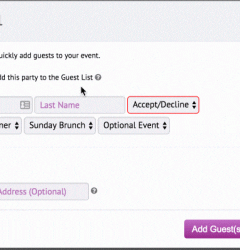11 Jun

How to use an event debrief template
So your event is over — what’s next? Time to debrief!
At RSVPify, we call the event debrief an event retrospective (“retro” for short). New to retros or looking to improve your existing debrief format? Let’s walk through how to use an event debrief template to measure event engagement and event ROI, identify areas of success and future growth, and improve future event planning.
Why should you use an event debrief template?
The purpose of an event debrief is to give your team a chance to come together and reflect on what went well and what can be improved for the next event. By looking across many areas — like financial results, attendance, marketing efforts, and overall logistics — teams collectively celebrate successes and learn from any challenges faced.
Event debriefs offer a place for open and constructive dialogue, and when done well, the event retro is a team-building and event buy-in activity. When your team can reflect together — creating shared memories of success and opportunity, they can also plan for the future together — creating shared expectations for your next event.
Who should attend an event debrief?
For the most inclusive retro, invite anyone who had a direct hand in the planning or execution of the event. If this makes your group quite big, you might consider hosting separate retros for more focused conversations — e.g., one retro for day-of operations (where you include a volunteer lead, check-in lead, technical + IT support, etc.) and another retro for fundraising (where you include your board, event committee, etc.).
Overview of an event retrospective
Part 1
The first part of the event retro outlines roles, goals, and ground rules:
- The roles are a readout of who does what during the conversation — e.g. facilitator, notetaker, participant role and expectation there.
- The goals are a readout of retro goal and a recap of the original/intended event goal(s). At this point, an initial report on goals is also shared (e.g. dollars raised, stewardship conversations had, attendee makeup, etc.).
- The ground rules typically outline values that are to be upheld in conversation – creating a safe and shared space for participants.
Part 2
In Part 1, you lay the groundwork for the retro conversation; part 2 is where the action happens! It is the heart of the event retro; it happens in three stages; and it is timed.
- First, all attendees make observations about the event — by whatever pre-planned variables/categories you decide are helpful. Observations fit into one of four categories — things to celebrate, that worked well, that didn’t work well, and ideas for the future — and you can pick the best categories. In general, you ask the participants to focus on their area of expertise — e.g., ask the marketing team to comment on event comms, sponsorships, media coverage, etc. and the finance team to take about collecting donations, app fees, reconciliation, etc.
- Second, attendees upvote the observations they agree with and/or want to discuss. Depending on the size of your group, you may want to limit the number of upvotes each person gets across the retro observations. Because some participants may need more time than others, you can ask those that are done upvoting to begin writing down “kudos” or shoutouts for team members that made great contributions along the way. These are read aloud in part 4.
- Third, group facilitated discussion. This is where a skilled facilitator really shines. They select topics to discuss – spending the most time on the constructive categories to address opportunities to do something different. The notetaker captures ideas as they are shared for the next event – to lead the discussion in part
Part 3
This is a fun follow-up. Ideas may have been shared during the discussion in part 2 as improvements for the next event. Building on this list, the facilitator opens the floor for a few minutes to surface other ideas for next steps. This list of “next steps” is shared generally in follow-up.
Part 4
This last part is optional – but usually a good team-building finisher. It‘s the kudos section.
Event planning is hard work – and every event is filled with moments that are important to recognize and celebrate. The kudos selection invites participants to recognize each other.
While some folks may have written kudos in part 2 (filling the remaining time to upvote), everyone in the retro spends a few minutes writing at least one kudogram. The facilitator selects one person to read the kudos aloud and folks can celebrate along the way.
Preparing for your event debrief - a template
To make the most out of your retro, here’s a template for prepping for the event debrief process.
Start by creating your retro team — Assign someone on your team to be:
- Facilitator: choose the person best at facilitation — not necessarily the leader of the event planning
- Note-taker: choose someone who you do not expect to actively participate in the conversation so they can focus on note-taking. If you can remember to record the conversation, that may be helpful as well.
- Timekeeper: if you don’t have a tool for this (zoom timer, alarm, etc.) choose someone who is not afraid to share when time is up
Pre-define a goal for the retro
Align with your team and your organization’s leadership about the purpose of the retro: to capture successes, learnings, and observations about the fundraising event to prep for the next event. Alignment here will create initial buy-in with your leadership to come with an open mind and act on feedback.
Prep any reports
Your retro should cover event fundraising, attendance, budget, and more. Be sure you’re prepared for the retro with whatever reports you might need to share with the group.
Prep your tools
A retro is different from a round-robin conversation (where everyone waits their turn to contribute). It’s easiest to choose a tool that will let folks participate at the same time.
- If you’re hosting your retro in-person, consider large flip-chart pieces of paper, post it notes and pens, and even colorful dot stickers (for upvoting).
- If you’re hosting your retro virtually, consider using an online retro tool — like a jam board or virtual whiteboard. If your team is tech savvy, you might consider repurposing an engineering retro board; our tech-loving team uses Notion for our retros.
Setup the conversation
The best participants are those that come to the meeting ready to participate.
- Email in advance. At least 48 hours in advance of your retro, share an agenda for the retro – complete with questions to consider so participants can get in the headspace for the conversation. Send a reminder 24 hours in advance.
- Setup in real-time. At the beginning of the conversation, remind participants of the purpose of the retro, outline ground rules for the conversation, and outline how the activity will go.
Prepare for Timed Breaks
If your conversation is one hour, you likely do not need a break, but if you’re planning for a longer conversation, it will be important to add time for a bio break for participants. One of the great things about breaks is the free flowing conversation that happens, inspired by the retro conversation. If your notetaker can be present for these breaks, that helps capture any nuggets for your team.
Prepare for Retro Follow-up
What will you commit to doing after the retro? Share notes from the meeting? Share a meeting summary? Make an idea list for the next event? Send a simple thank you to participants? Something else? Envision what your follow-ups will look like and who will do them to reduce the reporting burden.
Adam Hausman co-founded RSVPify in 2013 and has been passionate about event tech and ticketing software ever since. Also founder of Greenlight Growth Marketing, he holds degrees from Indiana University (BA English/Psychology 2008) and the University of Illinois-Chicago (M.Ed. Secondary Education 2012). He lives in Maine with his wife, 2 kids, and 2 annoying cats.










Adam Hausman